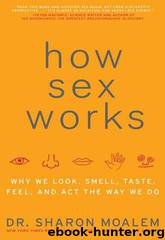How Sex Works: Why We Look, Smell, Taste, Feel, and Act the Way We Do by Sharon Moalem

Author:Sharon Moalem [Moalem, Sharon]
Language: eng
Format: epub
Tags: Science, Life Sciences, Biology
ISBN: 9780061479663
Google: LLxmFjpA5C4C
Amazon: 0061479667
Publisher: HarperCollins
Published: 2009-04-28T05:00:00+00:00
conditions in all three categories in this chapter.
As medical science has become more sensitive to and
h o w s e x w o r k s
❘ 1 4 3
thoughtful about these conditions, the language used to dis-
cuss them has evolved as well, moving somewhat away from
older terms, like hermaphrodite that are not particularly de-
scriptive from a medical perspective and have become laden
with pejorative connotation. At the 2005 Intersex Consensus
Meeting, attendees agreed to adopt the term disorder of sexual
development, or DSD, to cover the wide range of disorders that
prevent an individual from being identified as typically male
or typically female. The whole idea behind moving toward a
clinical-sounding phrase was exactly that—to move toward a
more scientific approach. Along those lines, the term intersex
itself has given way for some to DSD as well, although groups
like ISNA haven’t changed their names. Disagreement within
the intersex community still exists about whether the name
change is helpful. Cheryl Chase, executive director of ISNA,
told Scientifi c American it’s her hope that the name change will
encourage doctors to see DSDs as lifelong medical conditions.
“Now that we’ve accomplished the name change, culture can
accomplish a little magic for us.”
I N D E C E M B E R 2 0 0 6 , Santhi Soundarajan’s career as an
elite athlete was about to really hit its stride. She had just
won the silver medal in the women’s 800-meter race at the
Asian Games in Doha, Qatar, and seemed destined for the
2008 Olympic Games in China. And then, just hours be-
fore she was supposed to be honored, her silver medal was
taken from her, and she was barred from further competition
as a member of the Indian team by the Athletics Federa-
tion of India. For doping? Some other form of cheating? No.
144 ❘ S h a r o n
M o a l e m
She failed a sex test. Officials wouldn’t say exactly what the
tests showed, but according to the online science magazine
Inkling, some anonymous official told the Associated Press
that Soundarajan had “more Y chromosomes than allowed.”
Of course, one Y chromosome is all it usually takes to make
someone genetically male. Here’s the thing, though: Soun-
darajan had apparently passed sex exams many times before.
So what happened?
The exact nature of Soundarajan’s prior tests and the fi nd-
ings of the test that ultimately disqualified her aren’t publicly
known, but we can hazard a few good guesses. First of all,
it’s quite possible that Soundarajan’s initial exams were sim-
ply physical inspections of her genitals, and that she possesses
genitals that look sufficiently female to pass such a test. Fears
of men masquerading as women in athletic competition are
not unfounded, although as far as anyone knows, they are ex-
tremely rare. One of the few times it’s actually thought to have
occurred was during the 1936 Berlin Games when German
Hermann Ratjen competed as Dora in the high jump. Funny
thing is, he failed to place.
Soundarajan wouldn’t be the first athlete to pass a sex test
and later run into trouble because of a genetic analysis of chro-
mosome makeup that discovered a Y chromosome. The story
of Spanish hurdler Maria José Martinez-Patiño became well
known when she ran into problems in 1985 with the discovery
that she carried a Y chromosome.
Download
This site does not store any files on its server. We only index and link to content provided by other sites. Please contact the content providers to delete copyright contents if any and email us, we'll remove relevant links or contents immediately.
Rewire Your Anxious Brain by Catherine M. Pittman(18496)
Talking to Strangers by Malcolm Gladwell(13140)
The Art of Thinking Clearly by Rolf Dobelli(10148)
Mindhunter: Inside the FBI's Elite Serial Crime Unit by John E. Douglas & Mark Olshaker(9112)
Becoming Supernatural by Dr. Joe Dispenza(8045)
Change Your Questions, Change Your Life by Marilee Adams(7573)
The Road Less Traveled by M. Scott Peck(7480)
Nudge - Improving Decisions about Health, Wealth, and Happiness by Thaler Sunstein(7468)
The Lost Art of Listening by Michael P. Nichols(7365)
Mastermind: How to Think Like Sherlock Holmes by Maria Konnikova(7171)
Enlightenment Now: The Case for Reason, Science, Humanism, and Progress by Steven Pinker(7090)
Win Bigly by Scott Adams(7038)
The Way of Zen by Alan W. Watts(6459)
Daring Greatly by Brene Brown(6374)
Big Magic: Creative Living Beyond Fear by Elizabeth Gilbert(5562)
Grit by Angela Duckworth(5454)
Ego Is the Enemy by Ryan Holiday(5235)
Men In Love by Nancy Friday(5120)
Altered Sensations by David Pantalony(5013)
